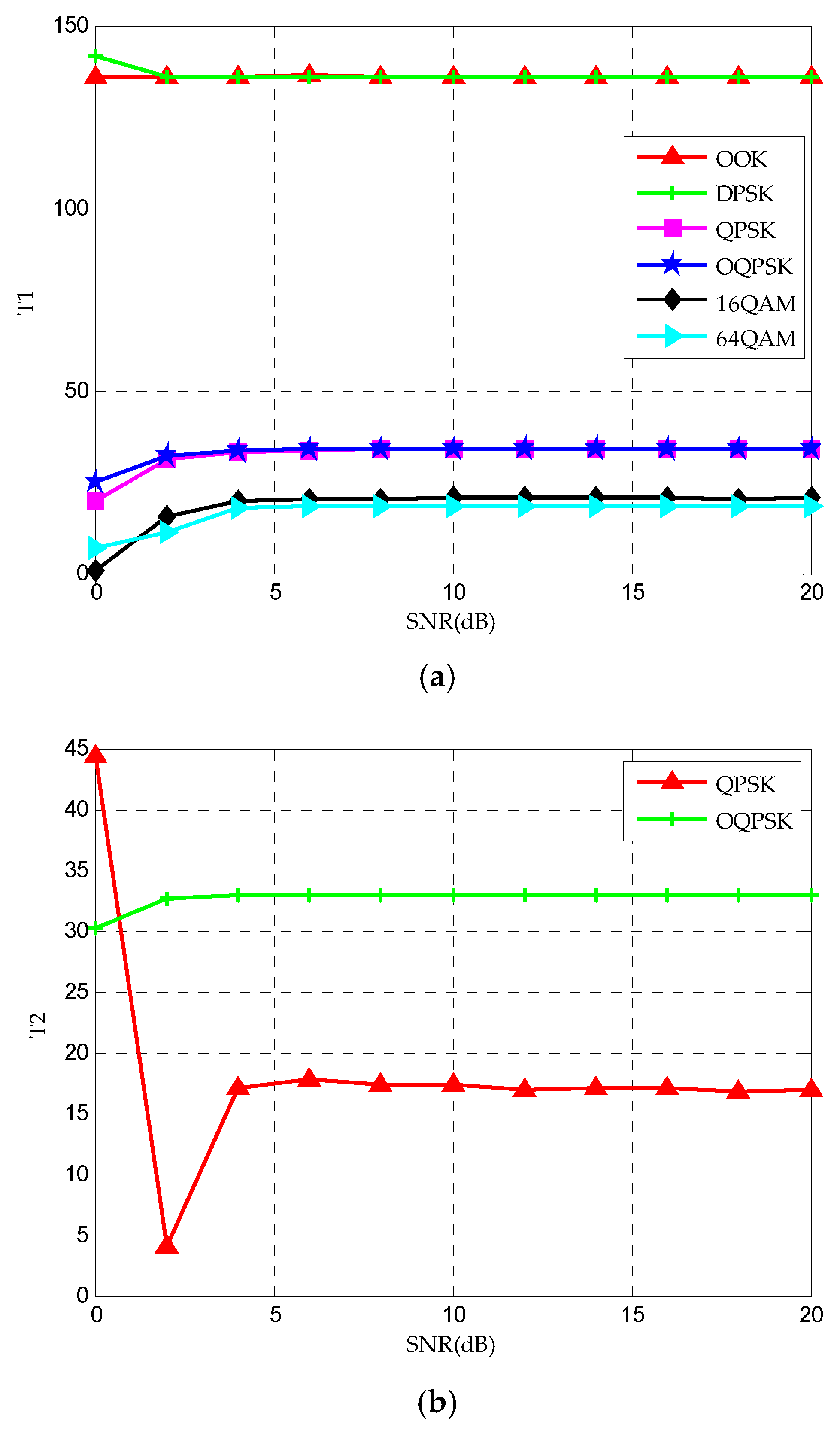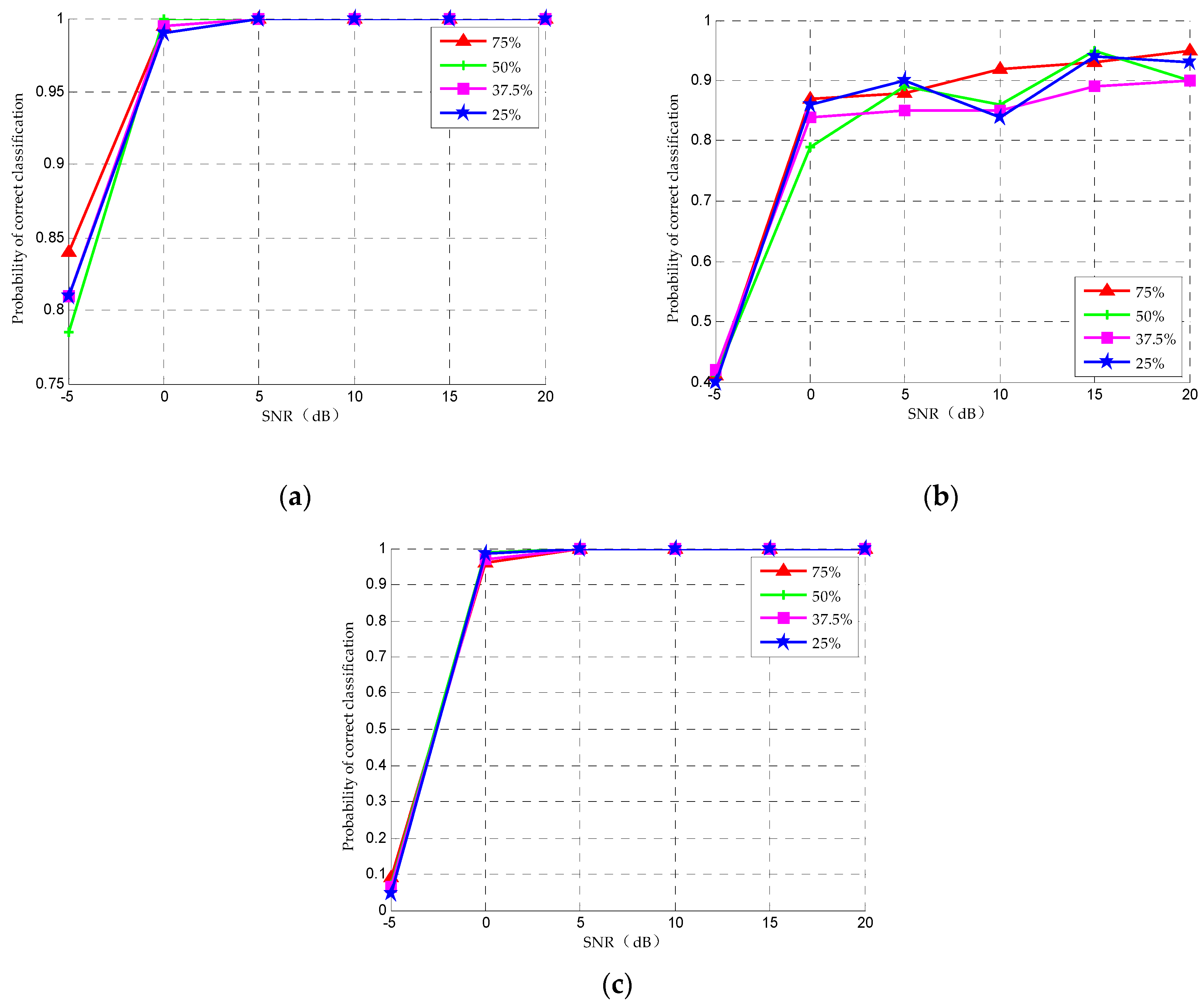Modulation Classification Using Compressed Sensing and Decision Tree–Support Vector Machine in Cognitive Radio System
Abstract
1. Introduction
2. Feature Extraction
2.1. Feature Extraction Based on Higher-Order Cumulant (HOC)
2.2. Feature Extraction Based on Cyclic Spectrum
3. Compressed Values of Feature Parameters Based on Compressed Sensing
3.1. Compressed Value of HOC
3.2. Compressed Value of Cyclic Spectrum
4. The Structural Process of Decision Tree–Support Vector Machine Classifier
4.1. The Principle of Support Vector Machine
4.2. The Structure of Decision Tree–Support Vector Machine Classifier
- (1)
- Three feature vectors are obtained from six kinds of wireless modulation signal data through feature extraction module;
- (2)
- (3)
- Six kinds of wireless signals are roughly classified by T1. The (OOK, DPSK) signals can be separated by SVM-1, and the remaining signals are classified into one class;
- (4)
- For (OOK, DPSK) signals, SVM-2 and T3 are used to realize classification;
- (5)
- By SVM-3 and T1, the residual signals can be divided into two categories: (QPSK, OQPSK) and (16QAM, 64QAM);
- (6)
- The T2 after differential operation and SVM-4 are used to classify QPSK and OQPSK;
- (7)
- Finally, the classification of 16QAM and 64QAM signals is realized by the T3 and SVM-5.
5. Simulation Results and Discussion
6. Conclusions
Author Contributions
Funding
Conflicts of Interest
References
- Zhu, X.; Fujii, T. A modulation classification method in cognitive radios system using stacked denoising sparse autoencoder. In Proceedings of the 2017 IEEE Radio and Wireless Symposium (RWS), Phoenix, AZ, USA, 15–18 January 2017; pp. 218–220. [Google Scholar]
- Chen, S.; Shen, B.; Wang, X.; Yoo, S. A strong machine learning classifier and decision stumps based hybrid adaBoost classification algorithm for cognitive radios. Sensors 2019, 19, 5077. [Google Scholar] [CrossRef] [PubMed]
- Sutton, P.; Nolan, K.E.; Doyle, L. Cyclostationary signatures in practical cognitive radio applications. IEEE J. Sel. Area. Comm. 2008, 26, 13–24. [Google Scholar] [CrossRef]
- Hu, H. Cyclostationary Approach to Signal Detection and Classification in Cognitive Radio Systems. In Cognitive Radio Systems; Wang, W., Ed.; Beijing University of Posts and Telecommunications: Beijing, China, 2009. [Google Scholar]
- Ganesan, G.; Li, Y.G. Cooperative spectrum sensing in cognitive radio Part I: Two users networks. IEEE Trans. Wirel. Commun. 2007, 6, 2204–2213. [Google Scholar] [CrossRef]
- Ma, J.; Li, G.Y.; Juang, B.H. Signal Processing in Cognitive Radio. Proc. IEEE 2009, 97, 805–823. [Google Scholar]
- Zhao, Q.; Sadler, B.M. A Survey of Dynamic Spectrum Access. IEEE Signal Proc. Mag. 2007, 24, 79–89. [Google Scholar] [CrossRef]
- Tandra, R.; Sahai, A. SNR walls for signal detection. IEEE J-STSP 2008, 2, 4–17. [Google Scholar] [CrossRef]
- Li, C.; Xiao, J.; Xu, Q. A novel modulation classification for PSK and QAM signals in wireless communication. In Proceedings of the IET International Conference on Communication Technology and Application (ICCTA), Beijing, China, 14–16 October 2011. [Google Scholar]
- Liu, J.; Luo, Q. A novel modulation classification algorithm based on daubechies5 wavelet and fractional fourier transform in cognitive radio. In Proceedings of the IEEE 14th International Conference on Communication Technology, Chengdu, China, 9–11 November 2012; pp. 115–120. [Google Scholar]
- Liu, A.; Zhu, Q. Automatic modulation classification based on the combination of clustering and neural network. J. China Univ. Posts Telecommun. 2011, 18, 13–19. [Google Scholar] [CrossRef]
- Xu, Y.; Li, D.; Wang, Z.; Liu, G.; Lv, H. A deep learning method based on convolutional neural network for automatic modulation classification of wireless signals. In Proceedings of the International Conference on Machine Learning and Intelligent Communications (MLICOM), Weihai, China, 5–6 August 2017; Volume 226, pp. 373–381. [Google Scholar]
- Liu, L.; Xu, J. A novel modulation classification method based on high order cumulants. In Proceedings of the International Conference on Wireless Communications, Networking and Mobile Computing, Wuhan, China, 22–24 September 2006. [Google Scholar]
- Chen, X.; Wang, H.; Cai, Q. Performance analysis and optimization of novel high-order statistic features in modulation classification. In Proceedings of the 4th International Conference on Wireless Communications, Networking and Mobile Computing, Dalin, China, 12–14 October 2008. [Google Scholar]
- Yuan, H.; Sun, X.; Li, H. The modulation recognition based on decision-making mechanism and neural network integrated classifier. High Technol. Lett. 2013, 19, 132–136. [Google Scholar]
- Liu, N.; Liu, B.; Guo, S.; Luo, R. Investigation on signal modulation recognition in the low SNR. In Proceedings of the International Conference on Measuring Technology and Mechatronics Automation, Changsha, China, 13–14 March 2010. [Google Scholar]
- Yoo, Y.; Baek, J. A novel image feature for the remaining useful lifetime prediction of bearings based on continuous wavelet transform and convolutional neural network. Appl. Sci. 2018, 8, 1102. [Google Scholar] [CrossRef]
- Wang, S.; Sun, Z.; Liu, S.; Chen, X.; Wang, W. Modulation classification of linear digital signals based on compressive sensing using high-order moments. In Proceedings of the European Modeling Symposium, Pisa, Italy, 21–23 October 2014. [Google Scholar]
- Zhang, X. Modern Signal Processing, 3rd ed.; Tsinghua University: Beijing, China, 2015; pp. 219–221. [Google Scholar]
- Hui, B.; Tang, X.; Gao, N.; Zhang, W.; Zhang, X. High order modulation format identification based on compressed sensing in optical fiber communication system. Chin. Opt. Lett. 2016, 14, 14–18. [Google Scholar]
- Candes, E.J.; Romberg, J.; Tao, T. Robust uncertainty principles: Exact signal reconstruction from highly incomplete frequency information. IEEE Trans. Inform. Theory 2006, 52, 489–509. [Google Scholar] [CrossRef]
- Baraniuk, R.G. Compressive Sensing. IEEE Signal Proc. Mag. 2007, 24, 118–121. [Google Scholar] [CrossRef]
- Candes, E.J.; Tao, T. Decoding by linear programming. IEEE Trans. Inform. Theory 2005, 51, 4203–4215. [Google Scholar] [CrossRef]
- Candes, E.J.; Romberg, J.K.; Tao, T. Stable signal recovery from incomplete and inaccurate measurement. Commun. Pur. Appl. Math. 2006, 59, 1207–1223. [Google Scholar] [CrossRef]
- Tsaig, Y.; Donoho, D.L. Extensions of compressed sensing. Signal Process. 2006, 86, 549–571. [Google Scholar] [CrossRef]
- Tian, Z.; Tafesse, Y.; Sadler, B.M. Cyclic feature detection with sub-Nyquist sampling for wideband spectrum sensing. IEEE J-STSP 2012, 6, 58–69. [Google Scholar] [CrossRef]
- Kirolos, S.; Laska, J.; Wakin, M.; Duarte, M.; Baron, D.; Ragheb, T.; Massoud, Y.; Baraniuk, R. Analog-to-information conversion via random demodulation. In Proceedings of the IEEE Dallas/CAS Workshop on Design, Application, Integration and Software, Richardson, TX, USA, 29–30 October 2006. [Google Scholar]
- Awe, O.P.; Deligiannis, A.; Lambotharan, S. Spatio-temporal spectrum sensing in cognitive radio networks using beamformer-aided SVM algorithms. IEEE Access 2018, 6, 25377–25388. [Google Scholar] [CrossRef]
- Yokota, S.; Endo, M.; Ohe, K. Establishing a classification system for high fall-risk among inpatients using support vector machines. CIN Comput. Inform. Nurs. 2017, 35, 408–416. [Google Scholar] [CrossRef] [PubMed]
- Zhang, W. Automatic modulation classification based on statistical features and support vector machine. In Proceedings of the URSI General Assembly and Scientific Symposium (URSI GASS), Beijing, China, 16–23 August 2014. [Google Scholar]






| OOK | 2 | 2 | 2 | 16 | 13 | 272 |
| DPSK | 2 | 2 | 2 | 16 | 13 | 272 |
| QPSK | 1 | 0 | 1 | 0 | 4 | 34 |
| OQPSK | 1 | 0 | 1 | 0 | 4 | 34 |
| 16QAM | 0.68 | 0 | 0.68 | 0 | 2.08 | 13.9808 |
| 64QAM | 0.619 | 0 | 0.619 | 0 | 1.7972 | 11.5022 |
| OOK,DPSK | QPSK,OQPSK | 16QAM | 64QAM | |
|---|---|---|---|---|
| T1 | 136 | 34 | 20.56 | 18.5819 |
| QPSK | 2 | 0 | 2 | 8 | 68 |
| OQPSK | 2 | 0 | 0.89 | 2 | 131.4 |
| QPSK | OQPSK | |
|---|---|---|
| T2 | 17 | 32.85 |
| SNR | SVM-1 | SVM-2 | SVM-3 | SVM-4 | SVM-5 | AVERAGE |
|---|---|---|---|---|---|---|
| Acc/% (c,γ) | Acc/% (c,γ) | Acc/% (c,γ) | Acc/% (c,γ) | Acc/% (c,γ) | Acc/% | |
| −5 dB | 88.33 (211.2,213.8) | 100 (20,20) | 81.25 (20.5,23) | 95 (2−2.5,215) | 100 (20,20) | 92.92 |
| 0 dB | 100 (2−8,22) | 100 (20,20) | 100 (2−5,28.5) | 100 (2−5,27.5) | 100 (20,20) | 100 |
| 5 dB | 100 (2−8,2−2) | 100 (20,20) | 100 (20,20) | 100 (20,20) | 100 (20,20) | 100 |
| SNR | Classification Accuracy of Cognitive Radio Signals (%) | ||||||
|---|---|---|---|---|---|---|---|
| OOK | DPSK | QPSK | OQPSK | 16QAM | 64QAM | AVERAGE | |
| −5 dB | 72.5 | 72.5 | 74.69 | 74.69 | 83.25 | 83.25 | 76.81 |
| 0 dB | 100 | 100 | 100 | 100 | 100 | 100 | 100 |
| 5 dB | 100 | 100 | 100 | 100 | 100 | 100 | 100 |
| 10 dB | 100 | 100 | 100 | 100 | 100 | 100 | 100 |
| 15 dB | 100 | 100 | 100 | 100 | 100 | 100 | 100 |
© 2020 by the authors. Licensee MDPI, Basel, Switzerland. This article is an open access article distributed under the terms and conditions of the Creative Commons Attribution (CC BY) license (http://creativecommons.org/licenses/by/4.0/).
Share and Cite
Sun, X.; Su, S.; Zuo, Z.; Guo, X.; Tan, X. Modulation Classification Using Compressed Sensing and Decision Tree–Support Vector Machine in Cognitive Radio System. Sensors 2020, 20, 1438. https://doi.org/10.3390/s20051438
Sun X, Su S, Zuo Z, Guo X, Tan X. Modulation Classification Using Compressed Sensing and Decision Tree–Support Vector Machine in Cognitive Radio System. Sensors. 2020; 20(5):1438. https://doi.org/10.3390/s20051438
Chicago/Turabian StyleSun, Xiaoyong, Shaojing Su, Zhen Zuo, Xiaojun Guo, and Xiaopeng Tan. 2020. "Modulation Classification Using Compressed Sensing and Decision Tree–Support Vector Machine in Cognitive Radio System" Sensors 20, no. 5: 1438. https://doi.org/10.3390/s20051438
APA StyleSun, X., Su, S., Zuo, Z., Guo, X., & Tan, X. (2020). Modulation Classification Using Compressed Sensing and Decision Tree–Support Vector Machine in Cognitive Radio System. Sensors, 20(5), 1438. https://doi.org/10.3390/s20051438




